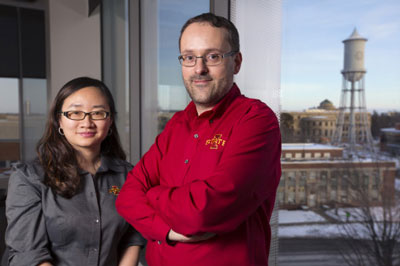| Feb 09, 2016 |
Engineers develop hybrid technology to create biorenewable nylon
|
|
(Nanowerk News) Engineers at Iowa State University have found a way to combine a genetically engineered strain of yeast and an electrocatalyst to efficiently convert sugar into a new type of nylon.
|
|
Previous attempts to combine biocatalysis and chemical catalysis to produce biorenewable chemicals have resulted in low conversion rates. That’s usually because the biological processes leave residual impurities that harm the effectiveness of chemical catalysts.
|
|
The engineers’ successful hybrid conversion process is described online and as the cover paper of the Feb. 12 issue of the journal Angewandte Chemie International Edition ("Combining Metabolic Engineering and Electrocatalysis: Application to the Production of Polyamides from Sugar").
|
|
“The ideal biorefinery pipelines, from biomass to the final products, are currently disrupted by a gap between biological conversion and chemical diversification. We herein report a strategy to bridge this gap with a hybrid fermentation and electrocatalytic process,” wrote lead authors Zengyi Shao and Jean-Philippe Tessonnier, Iowa State assistant professors of chemical and biological engineering who are also affiliated with the National Science Foundation Engineering Research Center for Biorenewable Chemicals (CBiRC) based at Iowa State.
|
 |
| Zengyi Shao and Jean-Philippe Tessonnier, left to right, are combining their expertise in biocatalysis and chemical catalysis to produce a new type of biobased nylon.
|
|
The process described by the engineers “opens the door to the production of a broad range of compounds not accessible from the petrochemical industry,” Shao said.
|
|
Moving forward, the engineers will work to scale up their technology by developing a continuous conversion process, said Tessonnier, who’s a Carol and Jack Johnson Faculty Fellow and also an associate scientist with the U.S. Department of Energy’s Ames Laboratory.
|
|
The engineers’ research was supported by CBiRC, the National Science Foundation, Iowa State’s Plant Sciences Institute and the Ames Laboratory.
|
|
Here’s how their technology works:
|
|
Shao’s research group has created genetically engineered yeast – “a microbial factory,” she said – that ferments glucose into muconic acid. By applying metabolic engineering strategies, the group also significantly improved the yield of the acid. Then, without any purification, Tessonnier’s group introduced a metal catalyst – lead – into the mixture and applied a small voltage to convert the acid. The resulting reaction adds hydrogen to the mix and produces 3-hexenedioic acid.
|
|
After simple separation and polymerization, the engineers produced biobased, unsaturated nylon-6,6, which has the advantage of an extra double bond in its backbone that can be used to tailor the polymer’s properties.
|
|
The engineers say the hybrid conversion technology offers many advantages: The reaction is performed at room temperature, it uses a cheap and abundant metal instead of precious elements such as palladium or platinum, and the other compounds involved in the reaction are produced from water.
|
|
“We gave it a try and it worked immediately,” Tessonnier said. “The process does not need additional chemical supplement, and it works amazingly at ambient temperature and pressure, which is very rare for this type of process.”
|
|
Shao and Tessonnier started talking about working together while car-pooling from a research meeting two hours from campus.
|
|
Their collaboration illustrates the CBiRC way – combining the tools of biologists and chemists to develop hybrid technologies that produce novel biorenewable chemicals. And now the resulting collaboration – and CBiRC’s core vision – are turning out discoveries and high-profile research papers.
|
|
“CBiRC seeds these new ideas and concepts,” Tessonnier said. “It’s all about integration.”
|
|
Shao agreed, saying, “CBiRC provides the nurturing environment to brainstorm what can be done with the expertise owned by two groups of experts who are trained through very different routes. This vision of these fields working together is going to grow. Students educated through such interdisciplinary research projects will definitely stand out with a broader vision in the biorenewable industry.”
|

